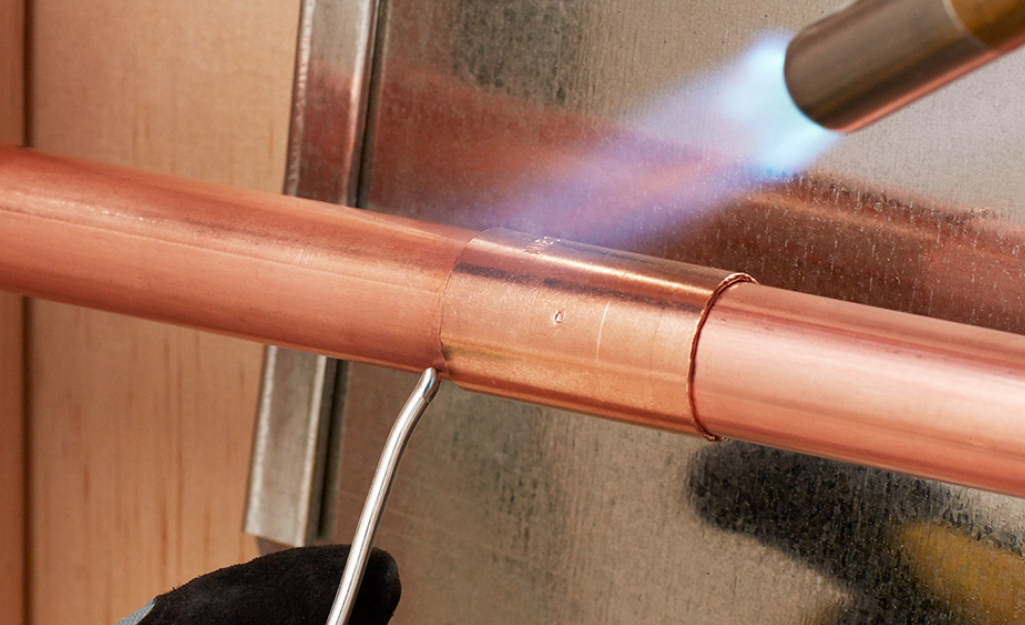Disclosure: This post contains affiliate links and I will be compensated if you make a purchase after clicking through my links. Learn More
Are you looking to install or repair copper pipes but can’t decide between crimping and soldering? You’re not alone.
This is a common dilemma faced by many DIY enthusiasts and professionals alike. Each method has its unique benefits and challenges, and choosing the right one can save you both time and money. We’ll dive into the nitty-gritty of copper pipe crimping and soldering, breaking down the pros and cons of each.
By the end, you’ll have a clear understanding of which technique best suits your needs, ensuring your plumbing project is a success. Let’s get started and find out which method will be your go-to for a seamless and efficient pipe installation!
Copper Pipe Crimping
Copper pipe crimping has become a popular choice for both professional plumbers and DIY enthusiasts. It offers a quicker and cleaner alternative to traditional soldering, allowing you to connect pipes with ease. Whether you’re fixing a small leak or installing a new water system, crimping is worth considering. But what makes it so appealing? Let’s dive into the details.
Advantages Of Crimping
Crimping is fast and efficient. You don’t need to wait for pipes to cool down as you do with soldering. This means you can complete your projects in less time. Additionally, crimping creates a strong, reliable seal that reduces the risk of leaks over time. Many users find it easier to learn and execute, making it a perfect choice for beginners. Imagine finishing your plumbing project without the hassle of handling hot tools or messy solder.
Tools Required For Crimping
To get started with crimping, you’ll need a few essential tools. A crimping tool, which looks like a pair of heavy-duty pliers, is your best friend. It applies pressure to the fitting and pipe, creating a secure connection. You will also need copper pipe fittings and a deburring tool to smooth the edges of cut pipes. Some might find these tools initially intimidating, but they’re designed for ease of use. Have you ever tried using a crimping tool? You might be surprised at how simple it is!
Common Applications Of Crimping
Crimping is versatile and can be used in various applications. It’s perfect for residential plumbing, such as connecting water lines to sinks or showers. It’s also widely used in commercial settings, offering a reliable solution for complex piping systems. Whether you’re tackling a small home repair or a larger project, crimping can be your go-to method. Have you considered how crimping might simplify your next plumbing task?
Choosing between crimping and soldering doesn’t have to be daunting. With crimping’s advantages and straightforward tools, you might find it the more appealing option. As you explore these techniques, think about how each method fits your needs and skill level. What might your next project look like with crimping in the mix?

Credit: www.reddit.com
Copper Pipe Soldering
Copper pipe crimping offers a faster alternative to soldering, reducing installation time significantly. Soldering, on the other hand, provides a more secure and durable connection, often preferred for its reliability in plumbing projects. Each method has its own advantages, making the choice dependent on specific project needs.
Copper pipe soldering is a technique that has stood the test of time, providing reliable and durable connections in plumbing systems. Whether you’re a seasoned professional or a DIY enthusiast, understanding the nuances of soldering can make or break your project.
Imagine the satisfaction of knowing your pipes are securely joined, preventing leaks and ensuring the smooth flow of water throughout your home. Let’s dive into the world of copper pipe soldering, exploring its benefits, essential equipment, and popular uses.
Benefits Of Soldering
Soldering creates a strong, watertight seal that withstands the test of time. Unlike crimping, which relies on pressure, soldering fuses metal together, ensuring stability. It is highly reliable for both hot and cold water lines. You don’t have to worry about pipe bursts due to weak joints. Soldering is versatile. You can use it for various applications, from plumbing to electrical connections, making it a go-to method for many professionals.
Essential Soldering Equipment
To start soldering, you need a few key tools. A soldering torch is crucial to heat the pipe and solder. Choose one that fits your hand comfortably. Solder is the bonding agent. Lead-free solder is preferred for plumbing to ensure safety. Flux helps clean the pipe and solder, ensuring a strong bond. Make sure you apply it generously before heating.
Popular Uses Of Soldering
Soldering is commonly used in plumbing repairs. If you’ve ever fixed a leaky pipe, you know the satisfaction of a job well done with a soldered joint. It’s also used in installing new plumbing systems. Imagine the pride in knowing your handiwork will serve for decades. Beyond plumbing, soldering is essential in electronics, connecting components securely.
Have you tried repairing a circuit board? Soldering could be your next adventure. Copper pipe soldering offers practical solutions, ensuring long-lasting connections. Do you prefer the reliability of soldered pipes over crimped ones?
Comparison Of Techniques
Choosing between copper pipe crimping and soldering involves understanding each method’s pros and cons. Both techniques have their unique benefits and challenges. Knowing these can help you make an informed decision. Let’s delve into the details.
Durability And Reliability
Soldering creates a joint using melted metal. This forms a strong, reliable bond. Soldered joints are less likely to leak or fail over time. Crimping, on the other hand, uses a compression tool. It creates a tight seal around the pipe. Crimped connections are also durable. But, they can be less reliable under extreme conditions.
Installation Time And Effort
Soldering takes more time and skill. It requires heating the pipe and applying solder. This process can be labor-intensive. Crimping is quicker and easier. It involves using a specialized tool. This tool compresses the fitting onto the pipe. Many find crimping more efficient for large projects.
Cost Implications
Soldering tools and materials can be costly. The process also requires experienced labor. This can increase installation costs. Crimping tools might have a high initial cost. But, they can save money in labor and time. Over time, crimping can be more cost-effective.
Safety Considerations
Working with copper pipes involves risk. Safety is crucial in pipe installation. Whether crimping or soldering, each method has its own risks. Understanding these risks can prevent accidents and ensure safe practices.
Risks In Crimping
Crimping copper pipes involves using a tool to press fittings. Incorrectly using the tool can cause leaks or pipe damage. Ensure the crimping tool is properly calibrated. Poor calibration can lead to weak joints. Weak joints may fail under pressure. Always wear safety gloves to protect your hands. Gloves prevent injuries from sharp pipe edges. Regularly inspect your crimping tool for wear and tear. A faulty tool increases the risk of failure.
Hazards In Soldering
Soldering involves heat and open flames. This method poses fire hazards. Ensure your workspace is free of flammable materials. Use a fire extinguisher nearby for emergencies. Soldering generates fumes that can be harmful. Use a mask to protect your lungs from fumes.
Make sure the area is well-ventilated. Poor ventilation can lead to fume inhalation. Always wear safety goggles to protect your eyes. Hot solder can splash, causing eye injuries.
Choosing The Right Method
Copper pipe crimping offers quick and clean connections, perfect for beginners. Soldering, though, provides durable, heat-resistant joints. Choosing wisely impacts longevity and ease of repair.
Choosing the right method for joining copper pipes is a crucial decision in plumbing and construction projects. The two popular techniques—crimping and soldering—each have their strengths and weaknesses. Understanding which method suits your specific needs can save you time, money, and effort.
This decision is influenced by various factors, including the nature of your project and your skill level. Let’s dive into these considerations to help you make an informed choice.
Project Type And Requirements
Every project has unique demands. Are you working on a small home repair or a large commercial installation? Crimping might be ideal for quick fixes, as it offers speed and efficiency. It’s perfect for projects where time is a constraint.
On the other hand, soldering provides a robust and durable connection, making it suitable for extensive plumbing systems that demand reliability. Consider the environment as well—soldering requires heat, which might not be safe in tight spaces.
Skill Level And Experience
Your experience matters. If you’re a DIY enthusiast, crimping is user-friendly. It doesn’t require the finesse that soldering demands. You can quickly learn the technique and achieve reliable results with minimal practice. Soldering, however, requires precision and patience.
If you’re confident with a torch and have experience in creating leak-proof joints, soldering can be rewarding. But ask yourself: are you ready for the challenge, or would you prefer a straightforward approach? Choosing between crimping and soldering is not just about the tools you have—it’s about the skills you bring.
Consider your comfort level and the time you can dedicate to mastering these techniques. Which method aligns best with your abilities and project goals?

Credit: www.homedepot.com
Future Trends In Plumbing
The plumbing industry is evolving rapidly with technological advancements and innovative methods. As you think about the future trends in plumbing, you might wonder how these changes will affect traditional practices like copper pipe crimping and soldering. Let’s dive into the innovations and advancements shaping these techniques.
Innovations In Crimping
Crimping technology is becoming more efficient and user-friendly. New tools are lighter and easier to handle, reducing fatigue during long installations. Have you ever struggled with bulky equipment during a job? These advancements aim to alleviate such issues.
Moreover, crimping fittings are becoming more reliable with improved seals. This means fewer leaks and a more secure connection. Imagine the peace of mind knowing your connections are built to last.
Smart crimping tools are also emerging, allowing you to connect pipes with precision and speed. Could these innovations be the answer to faster project completion?
Advancements In Soldering
Soldering is not being left behind in the race for efficiency. New soldering materials offer better flow and adhesion, making your job easier. Have you noticed the difference a quality solder can make?
Safety is a priority with advancements like lead-free solders, which are healthier for you and the environment. Would you prefer a safer option that doesn’t compromise on quality?
With induction soldering, you can achieve cleaner joints with less heat exposure. This could mean a more professional finish without the risk of damaging nearby components.
As you explore these trends, consider how they might fit into your current practices. Are you ready to embrace these changes and enhance your plumbing projects? The future of plumbing holds exciting possibilities for those willing to adapt. Which trend will you try next?

Credit: www.youtube.com
Frequently Asked Questions
What Are The Benefits Of Crimping Copper Pipes?
Crimping offers faster installations and reduces leakage risks. It’s ideal for tight spaces and quick repairs.
How Does Soldering Differ From Crimping?
Soldering involves heating and melting metal to join pipes. It requires more skill and time than crimping.
Which Method Is Safer, Crimping Or Soldering?
Crimping is safer due to its lower fire risk. Soldering involves open flames, increasing hazards.
Can Beginners Easily Crimp Copper Pipes?
Yes, crimping is beginner-friendly. It requires fewer tools and skills than soldering, making it accessible.
Final Words
Choosing between crimping and soldering depends on your project needs. Crimping offers speed and simplicity. It’s great for quick installations. Soldering ensures strong, durable joints. It’s ideal for permanent fixes. Consider your skills and tools available. Crimping requires a crimping tool.
Soldering needs a torch and solder. Both methods have their advantages. Safety is crucial in both processes. Ensure proper equipment and ventilation. Decide based on your specific requirements. Each method serves its purpose well. Make an informed choice for your plumbing tasks.
Your decision impacts the quality of the work.


